Identification of Georgian Glass | The English Plain Stem Drinking Glass
“Variety, Versatility and Veneration.”
Exhibit Antiques | Exhibit’s Private Plain Stem Collection
English plain-stem drinking glasses are the quintessential addition to any Georgian glass collection. In many ways, the name ‘plain’ conjures up the wrong image as they have a strength of character and a variety that many other 18th-century glass categories lack.
As a general rule, plain stems range from 1740 through to 1770. There are exceptions before 1740, primarily large goblets, and some dwindling examples after 1770 however the vast majority fall into this approximate 30-year period.
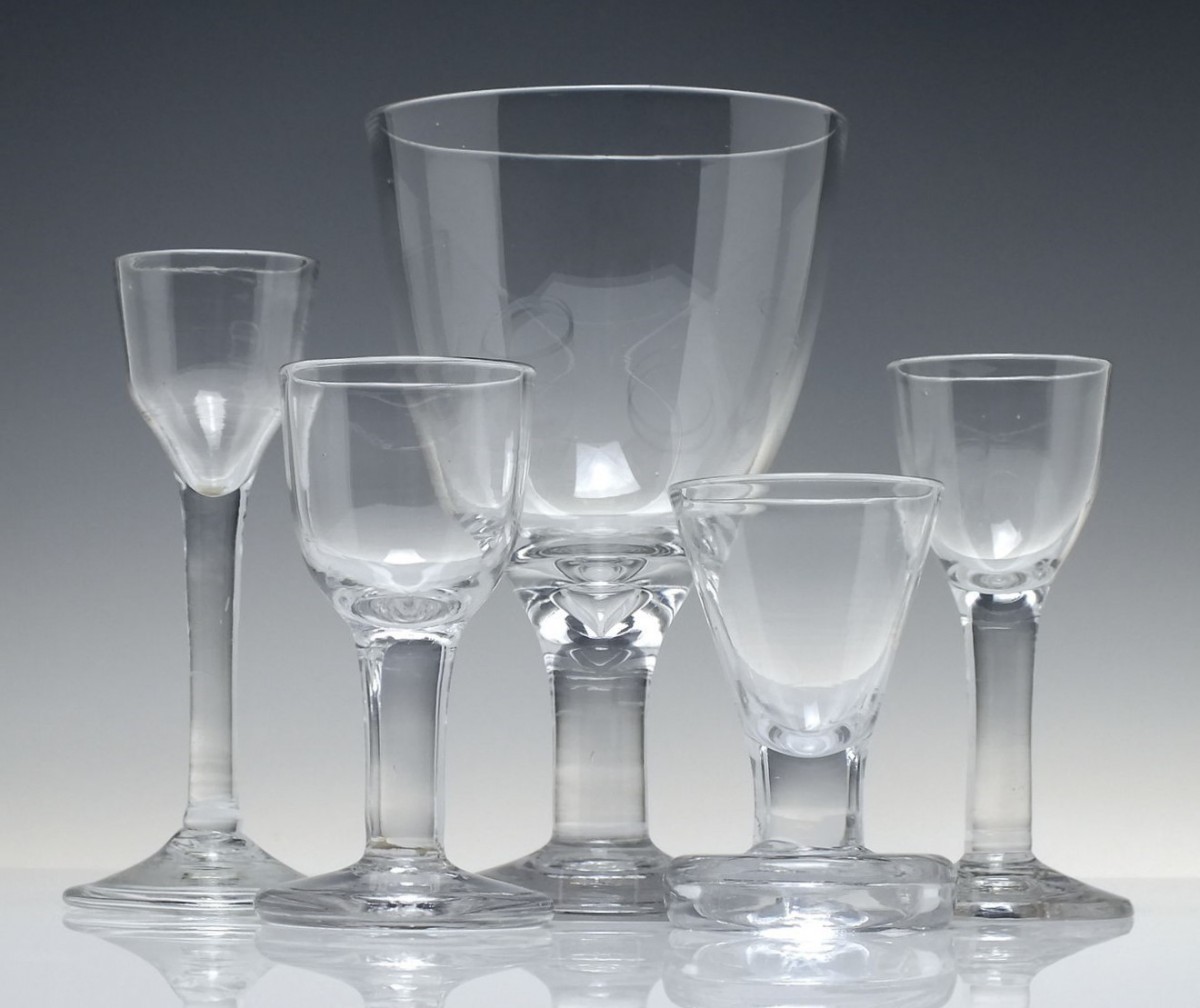
The form ranges from slender toasting glasses to heavy goblets and includes wines, ales, gins/drams, cordials, meads, ciders, champagnes and ratafias. With a wide variety of bowl types to choose from, a mixture of foot forms, moulding and engravings, there is always something exciting to add to your collection.
Numerically speaking, plain-stemmed examples account for approximately 25% of all 18th-century drinking glasses manufactured, as a result, they are quite common in relation to other Georgian drinking glass forms. Although simple forms are quite common, examples with special bowls or feet are still very difficult to find as most have disappeared into established collections.
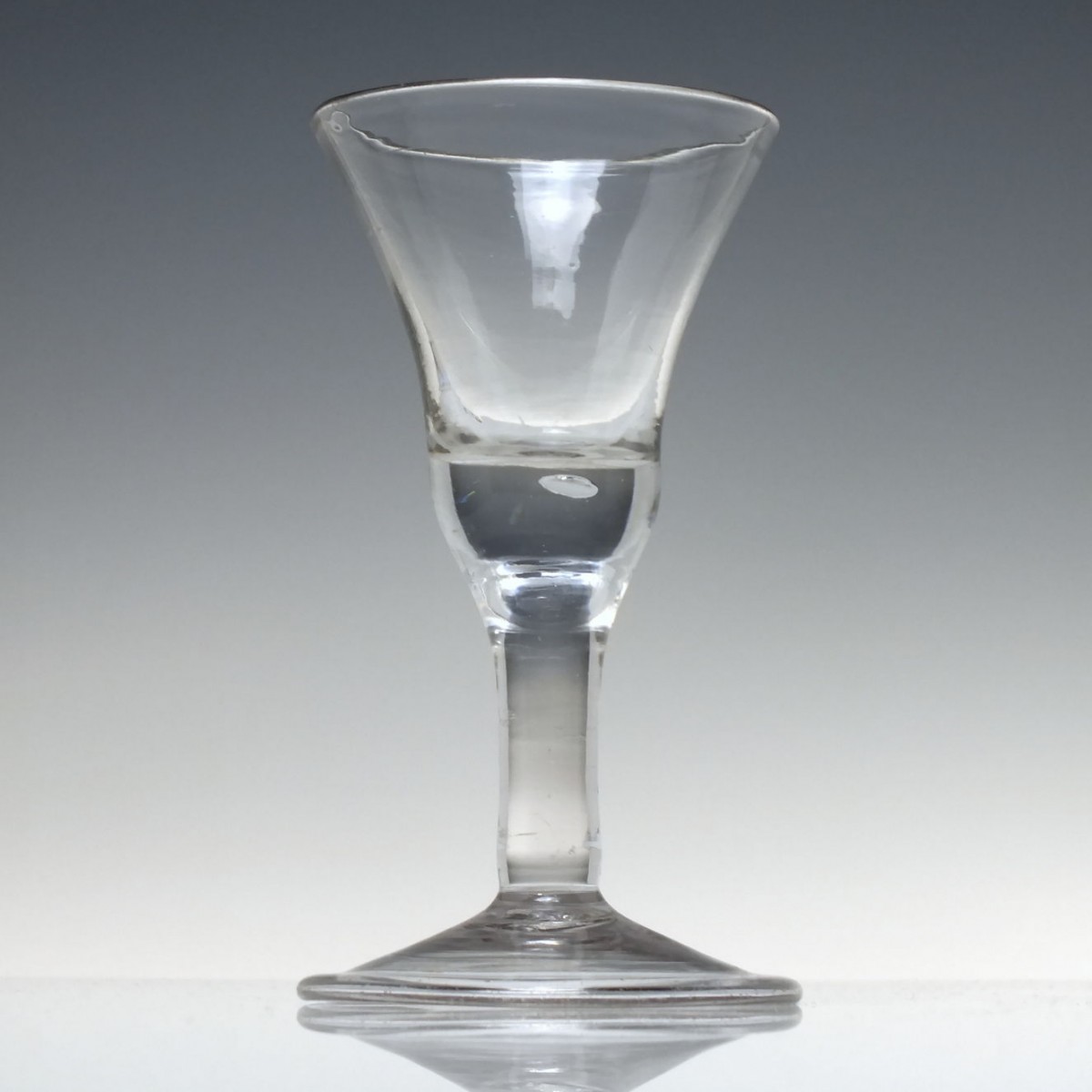
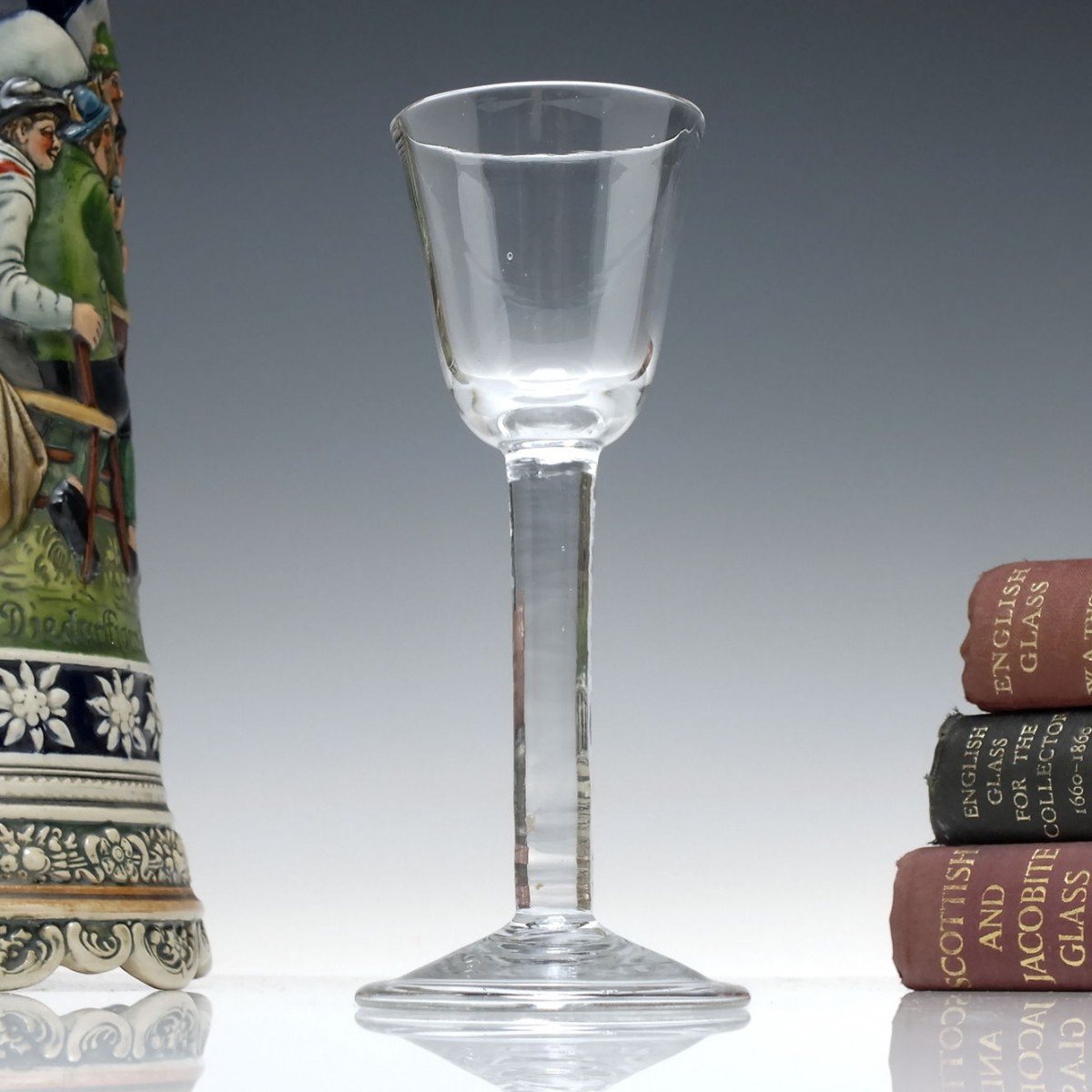
Left: Georgian Wine Glass c1740 | Two-part glass | Bell bowl with solid section, short-stemmed, folded foot.
Right: Georgian Wine Glass c1745 | Three-part glass | Round funnel bowl, folded foot.
Some distinction is needed pertaining to the construction of Georgian glasses; three-part and two-part. Simply, the two-part glass has a bowl which has been drawn out from the same piece of ‘metal’ (molten glass) as forms the entire stem, the only weld then is to attach the foot. Three-part glasses have an extra weld, typically directly below the attaching bowl. Most examples are evident, however, be aware that constriction tool marks may either falsely resemble a weld or equally cover one up. The join can also be made further down the stem and be obscured by a knop, this is particularly true for drop knops and in the case of composite drinking glasses.
Quick Tip: Tilt the glass to look through a suspected join for traces of the working, search for discrepancies in the metal texture and the occasional glint from a speck of trapped air.
Cider & Wine Glasses
All bowl types are represented within the plain stem category. Cider glasses are distinguished entirely by their engraving and present in the same form as a wine or ale glass. When addressing wine glasses, the trumpet bowl is the most numerous followed by the round funnel, ogee and ovoid. The bell bowl is a little more uncommon by comparison. Solid sections to the base of the bell bowl are quite common and transform into a thistle bowl when the base is closer to a solid ball. Singular air tears are another feature more common to the bell and trumpet bowls, it remains present but far more uncommon throughout the forms.

Georgian Glass | Plain Stem Wine Glasses
Left: Georgian Wine Glass | Thistle or bell bowl, folded foot.
Centre: Georgian Cider Glass | Exhibit Collection | Bell bowl with a solid section containing an air tear.
Right: Georgian Wine Glass | Bell bowl with a solid section containing an air tear, folded foot.
Authors’ Note: Understanding the construction method and toolset can be invaluable when identifying features as the craftsman sometimes made a ‘happy accident’ or an undocumented flourish. It becomes much easier for you to see the intention and execution of a technique and you are therefore able to judge whether or not an extra or different step was taken to achieve it, for example; A conical bowl requires that the tongs be held with one prong on each side of the bowl’s wall at a consistent angle, the tongs and glass in either hand must glide seamlessly back and forth perpendicular to each other as the glass spins away and towards the craftsman, if not, the glass will become uneven or be pulled askew. A tall conical bowl on a consistent stem suddenly becomes rather impressive and you start judging what a ‘nice’ glass is by how inspired the craftsman was that day.
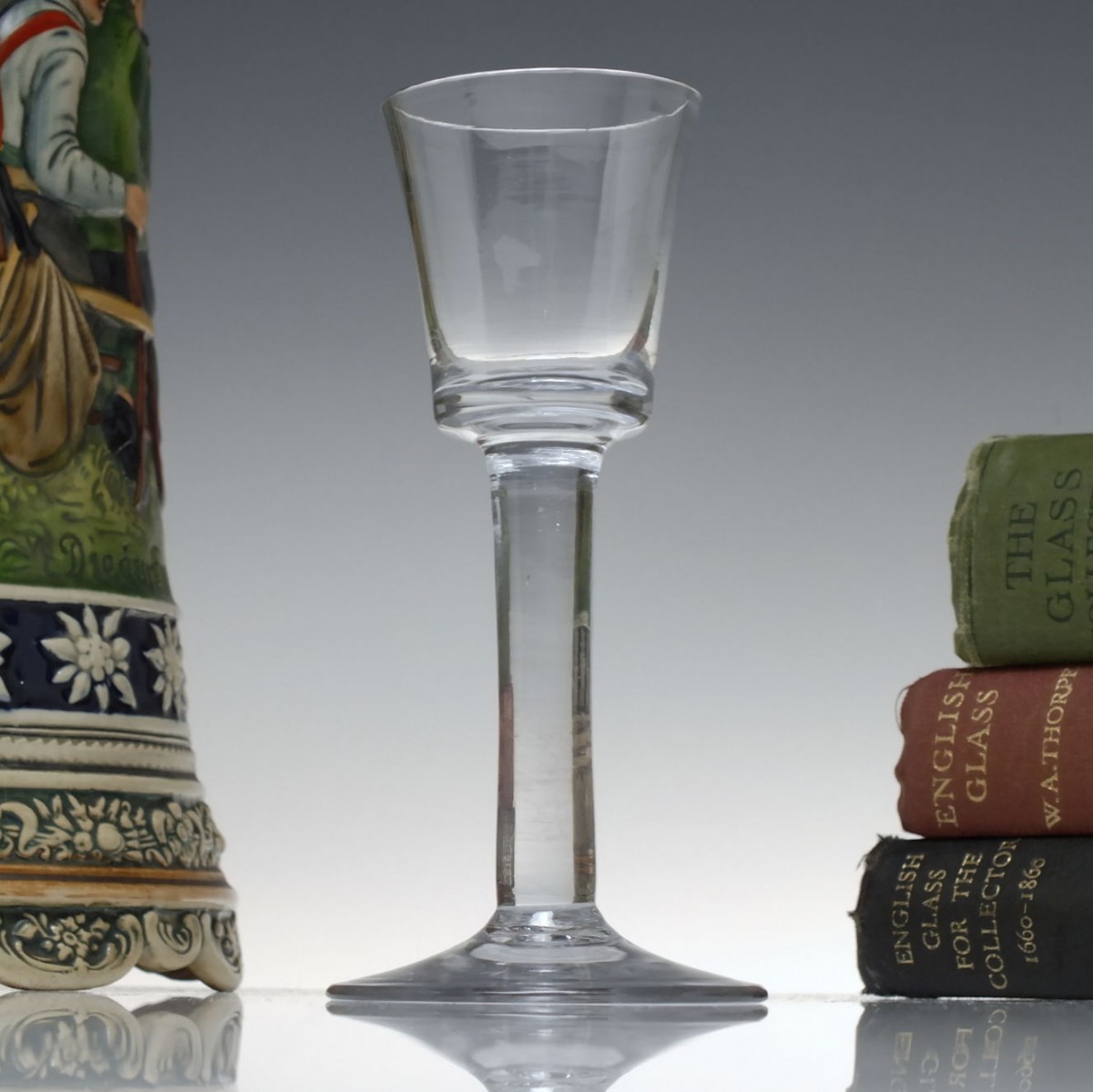

Left: Georgian Wine Glass c1750 | Bucket bowl, thick plain stem, conical foot.
Right: Georgian Wine Glass c1740 | Drawn cup bowl, folded foot.
Rare forms of the Georgian plain stem wine glass include the bucket, cup and thistle bowls. The so-called ‘tulip’ bowl, conical and ‘topped’ glasses, such as the pan-top, are exceedingly rare. Honourable mention: One recorded example is known of a lipped pan bowl (shown below - centre), the glass has been recorded previously by L.M.Bikerton as a wine glass and more recently as a sweetmeat at Delomosne. Not to be conflated with a pan-topped bowl.



Left: Georgian Wine Glass c1745 | Elongated, waisted and flared bucket bowl.Centre: Special thanks to Delomosne | Lipped pan bowl | © DELOMOSNE & SON, LIMITED
Right: Rare Georgian Wine Glass c1750 | Waisted round funnel, sometimes alternatively referred to as a ‘tulip’ bowl plain stem.
Some examples exhibit a bowl variant other than elongation in the case of ale glasses, by this, I’m referring to an alteration in the basic form. For instance, a ‘waisted’ or ‘flared’ bucket (shown above - left) is a variation, and so is a ‘lipped’ round funnel. It is one such variation, the exceeding rare ‘waisted’ round funnel, which is alternatively named ‘tulip’ bowl (shown above - right), I would argue somewhat erroneously as the same ‘tulip’ description is also given in the case of a cup-topped round funnel.
Collared Glasses


Left: Georgian Wine Glass c1750 | Air Twist with an applied vemicular collar.
Right: Special thanks to © The World is Made of Glass | Plain stem with an annulated collar.
The most well-known example of a collar is the vermicular collar which is typically applied as an undulating ring around the centre of a stem. In complete contrast to the air twist counterpart (above left), plain stem glasses exhibit their exceedingly rare ‘collar’ at either the shoulder (top of the stem) or more uncommonly the base, examples have also scarcely been recorded of both shoulder and basil collars in combination. However, one could argue that the collars are more akin to very thin cushion knops which may see some dealerships classify them as Balustroid glasses. A plain stemmed glass with a central collar may exist, however, thus far I’ve found none recorded.
Needless to say that the combination of form, variation and decoration will determine the overall desirability to the collector or investor.
Inherent Decoration



Left: Georgian Dram Glass c1760 | Drawn round funnel bowl with vertical flute moulding.
Centre: Lynn Rings - Fitzwilliam Museum
Right: Georgian Wine Glass c1750 | Round funnel bowl with rare hammer moulding.
Moulded decoration can also be found on a common to exceedingly rare basis, vertically fluted examples being the most represented. Rib, petal and panel moulding are rare, as well as horizontal banding known as Lynn rings which are rare regardless of where you find them. Textured surfaces such as honeycomb or hammer moulding are again rare. I also note one exceedingly rare record of a half-wrythen bowl, a technique usually reserved for dwarf ale glasses.
Exhibit Antiques Private Collection
This is a wonderful unorthodox form (above), one of only two that we have come across in the last 16 years and gifted by a client to our private collection. I include this to illustrate that the decoration can in some cases leave the form up for interpretation. If no impressed decoration had been applied to the bowl the form would likely have been classed as conical due to its straight-sided walls that taper directly towards the stem weld, a plain stem form that is quite rare in its own right. As you can see pressure has been applied enough so that the walls are slightly concave, changing the final profile to that of an ogee, though the ogee does not typically taper outwards and thus we would identify the tapering as a bowl variation.
External Decoration



Left: Georgian Wine Glass c1740 | Ogee bowl with an engraved floral band, folded foot.
Centre: Georgian Wine Glass c1740 | Round funnel bowl with engraved fruiting vines.
Right: Jacobite Sympathy Wine Glass c1740 | Ogee bowl with an engraved floral band, folded foot.
External decoration is easy enough to come by, the style lends itself to an engraved bowl that won’t be overpowered by an elaborate stem. Rarity in this case depends upon the subject matter, fruiting grape vines are a common occurrence followed by rim borders that were styled to resemble lace.
Examples of enamelling on plain stem glasses are exceedingly rare, by comparison, Beilby enamelling can be found on an opaque twist at a ratio of over 100:1, and again when compared with baluster glasses they remain rarer.



Left: Georgian Wine Glass c1750 | Drawn round funnel/ovoid bowl with vertical flute moulding and an engraved lace band of crosshatched swags and pendants.
Centre: Georgian Wine Glass c1740 | Ogee bowl with vertical flute moulding and engraved lace band of crosshatched swags and pendants
Right: Jacobite Sympathy Wine Glass c1740 | Drawn pointed round funnel/ovoid bowl, enrgaved with a budding Jacobite rose.


Left: Jacobite Wine Glass c1740 | Round funnel bowl with engraved Jacobite rose and oak leaf.
Right: Georgian Glass Goblet c1750 | Ovoid bowl engraved with fruiting vines and a mirrored monogram.
Ales, Champagnes, Ratifias & Toasting Glasses



Left: Georgian Plain Stem Ale Glass c1740 | Elongated round funnel bowl.
Centre: Georgian Plain Stem Champagne Flute c1750 | Drawn trumpet bowl.
Right: Georgian Plain Stem Ale Glass c1750 | Elongated bell bowl.
Pertaining to those glasses with elongated bowls, plain stem ale glasses are generally more uncommon than wine glasses with their own variations, including short stems, engravings and rarely, moulded decoration. Typically, round funnel examples are noted as ale glasses while trumpet bowls are often described as champagne flutes. This is purely an aesthetic reference and not based on the original use as a discrepancy exists where a hops and barley engraving may be found on the trumpet or bell form. Elongated trumpet and conical bowls are the most numerous with elongated round funnel bowls being a close second. The bell and ogee bowls become unexpectedly uncommon and a bucket bowl ale glass is seemingly scarce if not undocumented within the plain stem category.



Left: Rare Georgian Champagne Glass c1750 | Elongated and waisted bell bowl.
Centre: Georgian Plain Stem Ale Glass c1740 | Elongated ogee bowl.
Right: Georgian Plain Short-Stem Champagne Glass c1740 | Elongated bell bowl with a solid section, or an elongated thistle.
Georgian ale glasses of this form can be found readily with engraving, almost always the engraving is of hops and barley, rare examples of floral sprays exist and some with lace-like printie cuts typically found on faceted glasses which may be an example of second-hand later adornment but not necessarily. The most common occurrence of engraving by far is on short-stemmed ales with an elongated conical or round funnel bowl, followed by taller-stemmed glasses. An engraved trumpet bowl is uncommon and usually only exhibits a gentle curve, perhaps because the curved profile doesn’t lend itself well to the engraver’s wheel.
Toasting & Champagne Glasses


Left: Georgian Toasting Glass c1740 | Drawn trumpet, thin plain stem, conical foot.
Centre: Georgian Glass, Plain Stems | Exhibit’s Private Plain Stem Collection
Right: Georgian Toasting Glass c1750 | Drawn trumpet, thin plain stem, conical foot.
18th Century toasting glasses are impressively self-explanatory and among the finest Georgian drinking glasses produced, the formation of brow sweat upon handling a particularly thin-stemmed example testifies to their delicate nature. It is likely that other tall Georgian glasses were used to toast champagne, examples of wider bowled glasses resembling more of a coupe shape are also noted as champagne glasses, however, this wider (typically ‘double ogee’) form does not seem to exist within the plain stemmed category.


Left: Georgian Toasting Glass c1740 | Drawn trumpet bowl, plain stem, conical foot.
Right: Georgian Toasting Glass c1740 | Drawn trumpet bowl, plain stem with a long air tear, folded foot.
Ratifia glasses are generally uncommon glasses defined by their very narrow conical bowls and become a rare find within the plain stem category, more so than its opaque twist counterpart category.
One other glass exists of an elongated bowl, known as the ‘barley wine’ glass. The form presents as a typical ale or champagne with the key difference being an engraving that depicts ears of barley but is completely missing any depiction of the hops.
Cordial Glasses



Left: Georgian Cordial Glass c1750 | Drawn trumpet bowl with engraved fruiting vines
Centre: Georgian Cordial Glasses c1750 | Round funnel bowls with engraved fruiting vine, plain stems with air tears, domed/helmet feet.
Right: Georgian Cordial Glass c1750 | Drawn cup bowl.
The Georgian cordial glass is defined by an elongated stem and a bowl that is proportionally small but usually remains the same capacity as a typical wine glass. Majoritively found featuring a round funnel bowl, rarely a drawn trumpet, and any other bowl form becoming rarer still. Domed and helmet feet are available and do wonders to elevate the glass. In my opinion, the frequency of a domed foot appearing on a plain stem cordial glass is fairly high when compared to most other categories and glass types.
Thickness of Stems

Some of the most impressive plain-stem drinking glasses have significantly thicker stems than their counterparts, as a general rule their desirability increases in line with the thickness of the stem excluding in the case of toasting glasses. Georgian plain stem glasses are also considered to be thicker in the earlier years of production becoming almost half the width as their proliferation dwindled, given that the full plain stem production era may span from 1720 to 1780 other factors must be considered for chronology, such as evolving bowl styles, metal clarity and assembly techniques.
Although many thick-stemmed examples, primarily drawn trumpets, were produced in England prior to 1745, Ireland’s heyday muddies the waters. Over some years an increased number of thicker-stemmed examples have been attributed to the Irish Isle, to our knowledge, there is no documented evidence to back up this claim however the notion has merit; The infamous ‘glass excise tax’ imposed on England wasn’t introduced in Ireland until later in the 18th century. In order to compete where English production had been stifled glassblowers left for greener pastures while imports rose. It has been proposed that those glasses that can be almost twice as thick as a typical English plain stem are in fact a result of good gamesmanship by the Irish glasshouses during this period. If this is the case, not all Irish glasses had thicker stems as there are not enough of them in circulation today but certainly, the case is credible, especially in light of the odd Irish engraving upon a thicker stemmed glass.
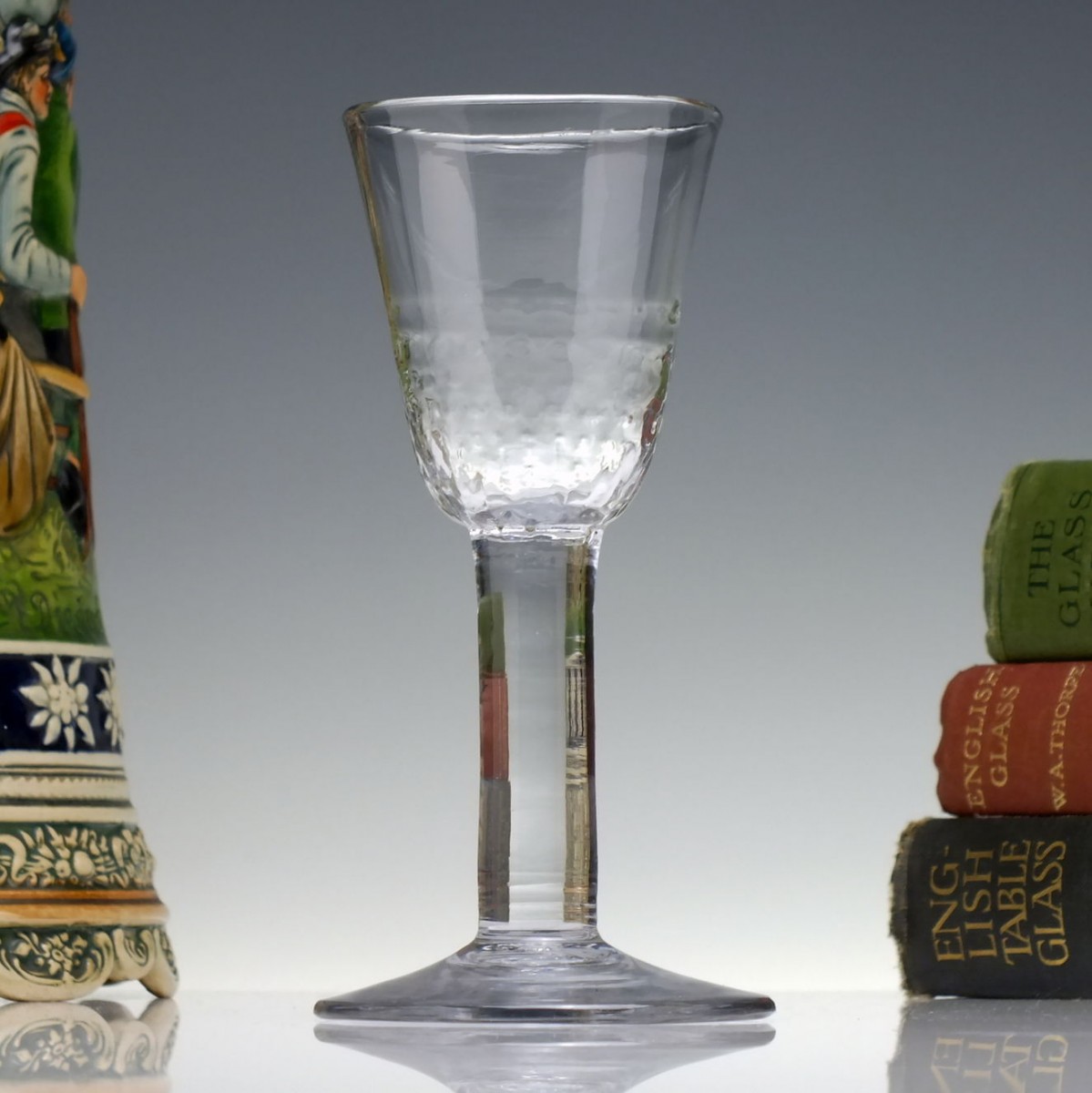
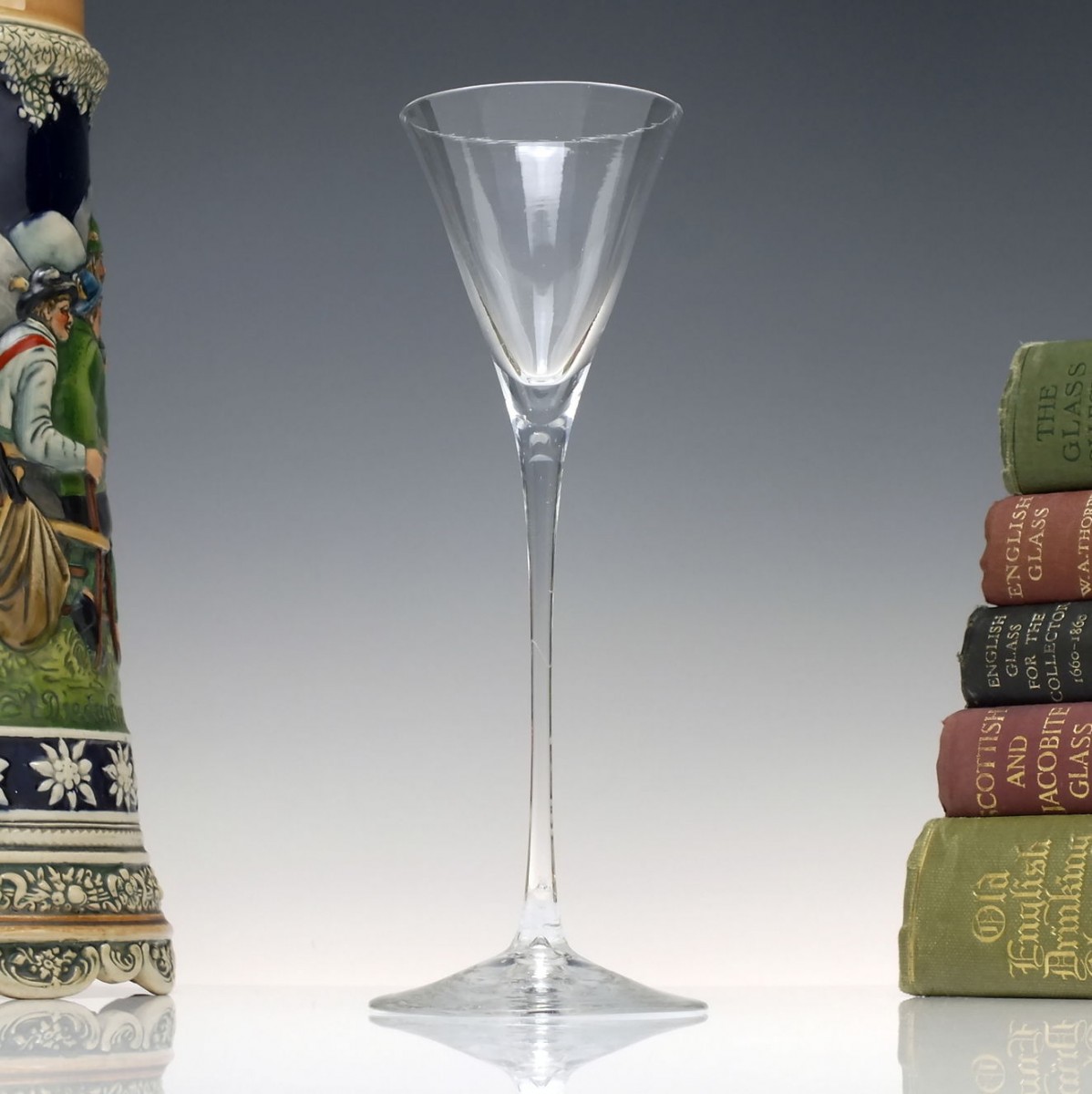
Left: Rare Georgian Wine Glass c1750 | Thickest example of a plain stem, honeycomb moulded bowl.
Right: Very Fine Georgian Toasting Glass c1710 | Thinnest example of a plain stem.
Dram Glasses
Very subtle differences in the description of shorter-stemmed glasses exist, this is usually to denote a short-stemmed wine, ale or champagne glass from a gin or dram glass. Fortified wine, ale, cider, gin, rum, brandy, whisky, sherry and champagne were all popular beverages in 18th-century England. Although some easy distinctions can be made regarding their use, such as in the case of an engraved ale glass, they are in fact quite standardised capacities and made to measure an amount that was socially acceptable according to the etiquette of the day. This leaves some open interpretation especially toward those glasses on short stems with a typical bowl size as they likely held a range of use.
Generally, a glass exhibiting roughly ½ the height of a typical stem will be noted as a short-stemmed wine or ale, whereas, a stem shorter than ½ the typical height will be described as a dram glass. Gin glasses are more often distinguished within the Balustroid family, within the plain stem category short-stemmed glasses with a conical bowl are commonly described as gin glasses however no evidence exists for this specific use case, the term is therefore interchangeable.


Left: Georgian Wine Glass c1740 | Short plain stem, folded foot.
Right: Georgian Firing Glass c1750 | Short plain stem, firing foot.
Plain stem dram glasses that exhibit an engraving are surprisingly uncommon, far more feature moulded decoration, specifically vertical flute moulding that typically covers half the bowl. Rarer examples feature fully fluted or fully rib moulded bowls, not to be conflated with one another. One recorded example of a half-ribbed bowl exists (below right), the first we have seen that exhibits the moulding over the top half of the bowl in this fashion.


Left: Georgian Firing Glass c1750 | Uncommon engraving of hops & barley, firing foot.
Centre: Uncommon Georgian Firing Glass c1750 | Rare bell bowl, firing foot.
Right: Rare Georgian Dram Glass c1760 | Rare half-rib moulded bowl, conical foot.
Some Georgian glasses exhibit a thickening of the bowl in the case of ‘deceptive’ glasses or a thickening of the foot in the case of ‘firing’ glasses. Both are so named to denote these exact features and both are exhibited across other Georgian glass families such as the opaque twist.
Deceptive glasses are supposed to have been used in settings where the patron may be duped into paying the same for less libation, hence the name. Deceptive glasses are also known as toastmaster glasses as historically the bowl allowed the fellow leading the toast, ‘the toastmaster’, to drink a smaller sample upon each raised glass allowing him to retain his composure for longer.



Left: Georgian Deceptive Toastmaster Firing Glass c1750 | 3 Part Glass, deceptive round funnel bowl, firing foot.
Centre: Georgian Deceptive Toastmaster Firing Glass c1750 | 2 Part Glass, deceptive drawn round funnel bowl, firing foot.
Right: Georgian Deceptive Toastmaster Dram Glass c1750 | 2 Part Glass, deceptive conical bowl.
One of the most delightful aspects of the dram glass is the originality when it comes to the foot. The variety is extensive and holds the most scope by far when compared to other families of drinking glasses. Included below are some more uncommon and rare plain stem dram glasses, also an extra plain stem wine glass has been included to show a scarce example of a round lemon-squeezer-like foot.



Left: Jacobite Firing Glass c1750 | Engraved Jacobite rose & thistle, drawn trumpet bowl, firing foot.
Centre: Georgian Firing Glass c1780 | Drawn trumpet bowl, uncommon flanged foot. A brighter metal may indicate a slightly later date.
Right: Georgian Firing Glass c1750 | Drawn trumpet bowl, uncommon terraced foot.


Georgian Dram Glass c1750 | Vertically fluted bowl, uncommon terraced foot.

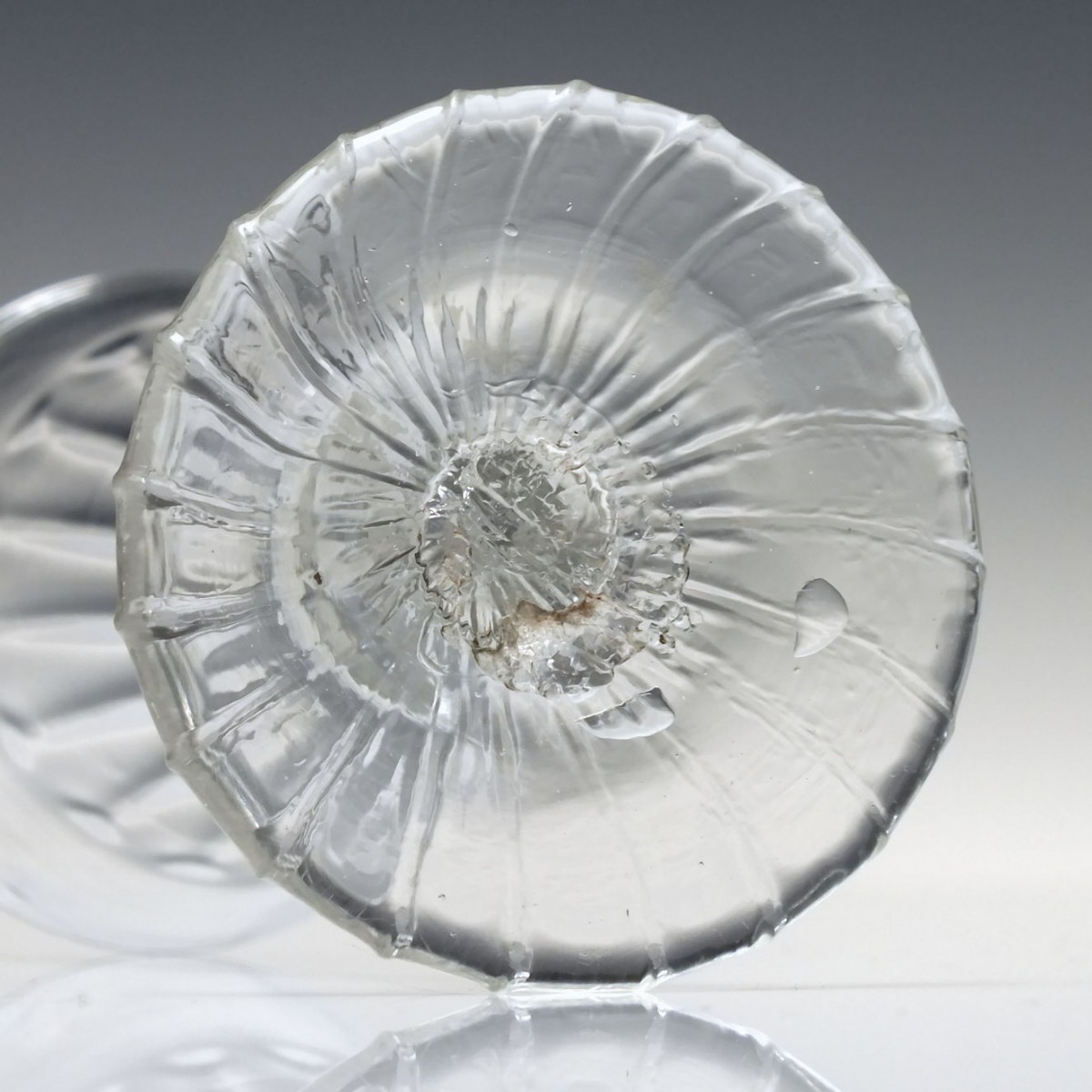
Rare Georgian Dram Glass c1760 | Vertically fluted bowl, uncommon oversewn foot.


Rare Georgian Dram Glass c1750 | Vertically fluted bowl, rare under-sewn foot.


Exceedingly Rare Georgian Dram Glass c1750 | Vertically fluted bowl, exceedingly rare scalloped/petal foot.
Georgian Glass | Trumpet bowl, plain stem with an air bead, domed and folded foot.
Georgian Glass | Trumpet bowl, plain stem, exceedingly rare hollow helmet foot.
Georgian Glass | Drawn conical bowl, plain stem, undocumented round press moulded foot.
The Folded Foot
In relation to English glass production, the folded foot was introduced early in the 18th century, primarily to protect the glass from damage (it is actually quite rare to find a folded-foot glass that has been chipped, so the design worked very well). The fold is quite common on plain stemmed glasses, specifically on those manufactured prior to the 1745 Excise act, after which as a general rule the fold is thought to have dwindled in use or disappeared completely in order to save weight. I would say that it probably continued to be used, perhaps on customer request, but in much fewer numbers and was no longer the norm.
Glassmakers had a few other ways to counteract the issue of taxed weight, mainly that lead glasses from 1675 onwards contained typically between 13% and 33% PbO/lead, controlling the recipe would have been advantageous and a likely consideration in 1745.
It is worth mentioning that from our experience, the wider the fold, the earlier the glass, with later examples having quite precise, narrow, uniform folds. Many collectors prefer folded feet examples as it not only gives the glass that extra character but is also a good indicator that the foot has never been reduced to remove chips.



Left: Georgian Gin Glass c1740 | Drawn conical bowl, folded foot.
Centre: Georgian Gin or Port Glass c1740 | Rare fully rib moulded bowl.
Right: Georgian Port Wine Glass c1780 | ‘Double ogee’ bowl (infact a cup-topped bucket bowl), folded foot.
The folded foot did make a resurgence in England towards the end of the 18th century, primarily on small drams and dating these examples can be more difficult. Again from our experience, the later examples tend to have quite flat feet and very narrow folds as compared to the typical conical foot from earlier in the period, also exhibiting later bowl forms such as the so-called ‘double ogee’.
Folded feet can also be found on many continental glasses much earlier than the 18th century with many having very small precise folds which are again there to protect the foot from damage. The folded foot remained a design feature of many later glasses produced in the 19th and early 20th centuries. Some later examples from the 20th century can have thickened foot rims rather than classic folds and can be very convincing to the untrained eye, but as with most glasses from this era, the clarity of the metal, manufacture techniques, tooling etc are all good indicators to a later glass.
The Excise Act of 1745
As mentioned, the glass excise tax was first levied by Parliament in 1745 and although all types of glass were subject to this tax, including window and bottle glass, the highest rates were reserved for flint and white (opaque) glass. The tax was applied to the weight of the metal coming from the furnace pot so that it was the manufacturer not the consumer that was most concerned. Most notably the introduction of Hollow stemmed glasses are said to have been a reactionary measure, however, their numbers do not indicate that this form became a widespread practice likely restricted to only a few glass houses and only being produced for a short time between 1745-60.
Some consider the hollow stem to be a subcategory of plain stem glasses, they are certainly rare and according to Barrington Haynes, they only account for approximately 0.5% of all 18th-century drinking glasses produced. Of those still in circulation today, the plain hollow cylinder tube with a trumpet bowl is certainly the most numerous and they make a very fine addition to any collection. Our own observations would not contradict this rarity, however, in my view, the historical relevance, technique and finished product differ enough to warrant its own family of classification.



Left: Georgian Hollow Stem Wine Glass c1750 | ‘Excise Glass’ | Trumpet bowl, plain hollow stem.
Centre: Georgian Hollow Stem Wine Glass c1750 | ‘Excise Glass’ | Trumpet bowl, engraved star & printie cut band, plain hollow stem.
Right: Rare Green Georgian Hollow Stem Wine Glass c 1760 | ‘Excise Glass’ | Excedingly rare green glass example, plain hollow stem.
Related Books & Studies of Interest
Glass Through the Ages
E Barrington Haynes
Published by Pelican
The Arthur Negus Guide to British Glass
John Brooks
Published by Hamlyn
Eighteenth Century English Drinking Glasses An Illustrated Guide
L.M.Bickerton
Published by Antique Collectors Club
Investigation of Late 17th Century Crystal Glass
D Dungworth and C Brain
Centre for Archaeology Report 21/2005
Special Thanks
A special thanks to those private collectors who have provided access in documenting their ongoing collections.
Article Author | Nicola Smillie